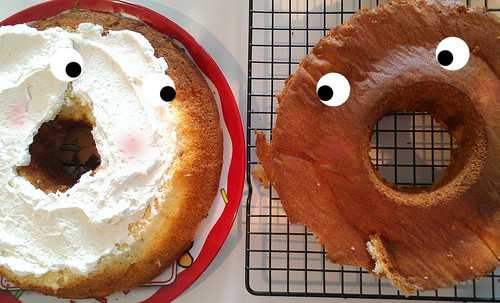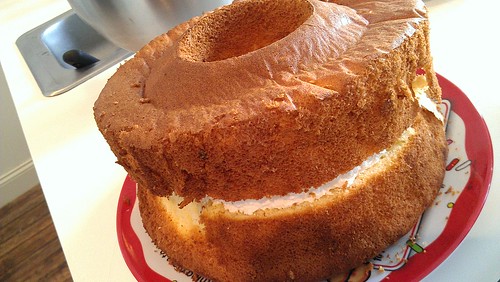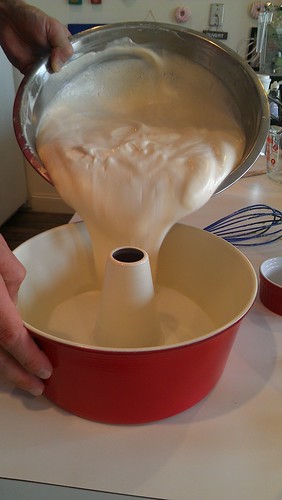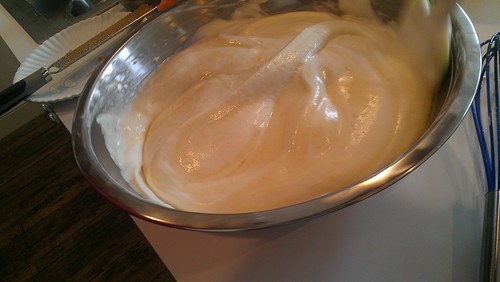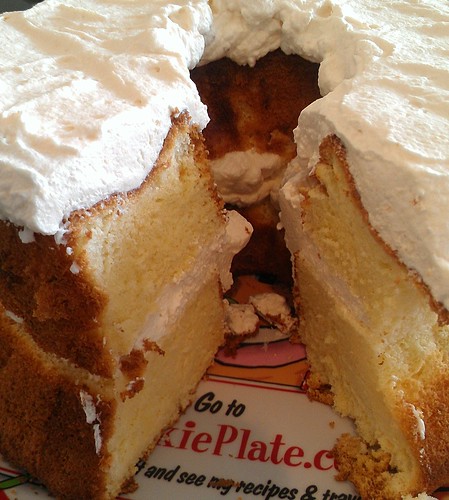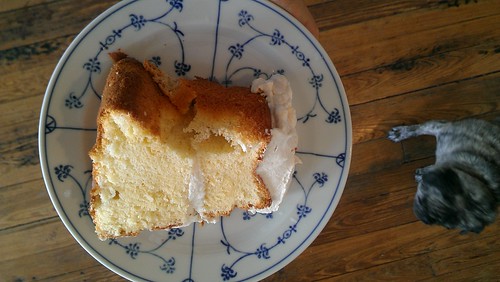CakeSpy Note: Serious thanks to Sandy's Chatter and writer Joe Hart for sharing their stories and research with me!
If there was ever a cake to have a rags to riches, Lana Turner-type Hollywood discovery, it was chiffon cake, a light cake with a delicate crumb that physically resembles angel food cake, but with a far richer flavor. But even before being famously debuted and promoted as the “first new cake in 100 years” on its grand release to the public in 1948, the tale of the chiffon cake was unfolding glamorously in Hollywood . . .
It all started with Harry Baker, who went to Hollywood in 1923, needing a fresh start. Exactly why isn't quite known, but some suspect it's because he was outed as homosexual in his hometown (sadly, not as OK then as it is today). He found work as an insurance salesman, but moonlighted as a caterer; it was during this time that he began to experiment with cake recipes. To describe Harry Baker as a “hobby cook” is an understatement--this cake was more like his Moby Dick. He later revealed that he tested over 400 recipes, seeking what he hoped would be a moister, more substantial version of the then-popular angel food cake. Was the recipe that finally worked a fluke, or a stroke of masterful baking? Perhaps a bit of both.
What finally ended up working, in 1927, is seemingly quite simple: he used vegetable oil (sometimes referred to as "salad oil") instead of solid shortening or butter in his recipe. The cake employs egg whites for lift, and the resulting cake is tantalizingly light, like angel food, but with a far richer flavor. Later, he would tell a Minneapolis Tribune reporter that the addition of the vegetable oil was "a sixth sense, something cosmic."
He approached the nearby Brown Derby restaurant (famous as the place where the Cobb Salad was invented) with this cake, and they agreed to sell it—it was the first (and for a time) the only dessert they offered.
As the Derby gained fame, so did the chiffon cake, and requests began to pour in from the likes of Barbara Stanwyck.
By the 1930s, he was having to turn away orders. (Wisely, Baker kept his methods and ingredients a secret; it was this mystery that made it a highly sought-out sweet treat for the elite.) He remained a one-man operation, mixing each cake to order; at the height of production, Baker was producing 42 cakes in an 18-hour day, which yielded him the equivalent of nearly $1,000 in today’s money.
How was it done, people (especially copycats) wanted to know? For two decades, Harry Baker wouldn't tell. Finally, in 1947, he approached General Mills, the food manufacturing giant, to see if they might have an interest in acquiring the recipe. (Even they had been unable to figure out the secret.) They eventually paid up with what is still an undisclosed price for the recipe. They unveiled it to the public a year later, making a huge to-do about it, calling it "The first new cake in 100 years" in a big article in Better Homes and Gardens. The first published recipe was for Orange Chiffon Cake, ;and it rose to stardom as quick as you can say "Lana Turner."
Later, an ad for Sperry Drifted Snow flour called it “The baking sensation of the century!," touting its richness yet simplicity to make--so easy that you could even "have your husband bake one."
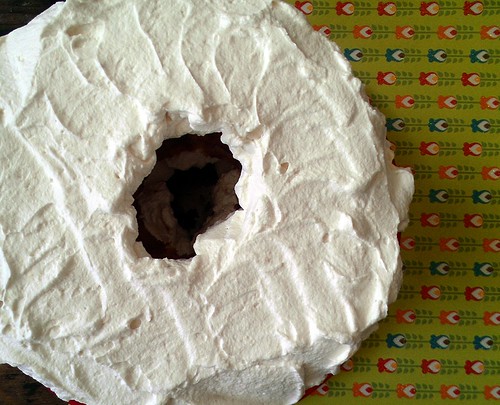
This version of Harry Baker's famous cake, inspired by a Brown Derby recipe, is said to have been favored by a fat gossip columnist who considered the grapefruit cake acceptable diet food! It's a study in pleasant contrasts: light yet rich, sweet yet tart, simple yet layered in flavor.
Grapefruit Chiffon Cake
Makes one 10-inch tube cake (12 servings)
For the cake:
- 2 1/4 cups cake flour (not self-rising)
- 1 1/2 cups sugar, divided
- 1 tablespoon baking powder
- 1/2 teaspoon salt
- 1/2 cup vegetable oil
- 7 large eggs, separated, plus 2 additional egg whites (7 yolks and 9 whites)
- 3/4 cup freshly squeezed grapefruit juice (from 3 large grapefruits)
- 2 tablespoons grapefruit zest
- 2 teaspoons vanilla extract
- Pinch of salt
- 1 teaspoon cream of tartar
For the filling:
- 2 cups heavy cream, chilled
- 2 tablespoons light rum (optional)
- 2 teaspoons grapefruit zest
- 1/4 cup sugar
- Pinch of salt
Procedure
- Position a rack in the center of the oven and preheat the oven to 325 degrees F. Have ready an ungreased 10-inch tube pan, 4 inches deep, with a removable bottom.
- To make the cake, in a large bowl sift the flour, 3/4 cup of the sugar, baking powder, and salt. Set aside.
- In a separate bowl, whisk the oil, egg yolks, grapefruit juice and zest, and vanilla until lightly frothy. Add this mixture to the flour mixture, whisking until the batter is smooth.
- In the clean, dry bowl of a stand mixer fitted with the whisk attachment, beat the egg whites with a pinch of salt until they are foamy. Add the cream of tartar, and on medium-high speed, beat the whites until they hold stiff peaks. Add the remaining 3/4 cup sugar a little at a time, and on medium speed, beat the whites until they hold stiff, glossy peaks.
- Stir one third of the whites into the egg yolk mixture to lighten it; fold in the rest of the remaining whites gently but thoroughly.
- Spoon the batter into the tube pan, and bake the cake for 50-60 minutes, or until a tester inserted into the center comes out clean.
- Run a long, thin knife around the outer and inner edges of the pan. Invert the pan onto a rack and let the cake cool completely in the pan, upside down on the rack. Using a serrated knife, cut the cake in half horizontally.
- To make the filling, chill a large bowl in the refrigerator. Using an electric mixer, beat together the cream, rum, grapefruit zest, sugar, and the pinch of salt until the mixture holds firm peaks. Cover the cream tightly and keep it chilled until you're ready to frost the cake.
- To assemble the cake, transfer the bottom (wider) layer of the cake to a platter and spread about half of the frosting on it. Set the remaining cake half on top, and top it with the remaining cream. If desired, garnish with additional grapefruit zest or thin slices of grapefruit.
- Serve immediately after assembling. This cake is best served the same day; store, loosely covered, in the refrigerator.

